Sainsbury's Strategic Options: Analysis, Evaluation, and Monitoring
VerifiedAdded on 2023/06/13
|21
|6223
|305
Report
AI Summary
This report provides a comprehensive analysis of Sainsbury's business strategy, encompassing both internal and external environmental factors. It begins with a PESTLE analysis to evaluate the impact of macro-environmental factors such as political, economic, social, technological, legal, and environmental elements on Sainsbury's operations. A SWOT analysis is then conducted to assess the company's internal strengths, weaknesses, opportunities, and threats. The report also evaluates Sainsbury's resources and capabilities using the VRIO framework, identifying valuable, rare, inimitable, and organized resources that contribute to its competitive advantage. Furthermore, Porter's Five Forces model is employed to analyze the competitive intensity within the retail industry. The report concludes by critically evaluating strategic options available to Sainsbury's, recommending appropriate growth platforms, and suggesting methods for monitoring the chosen strategies to ensure success. Desklib offers a variety of resources for students, including past papers and solved assignments.
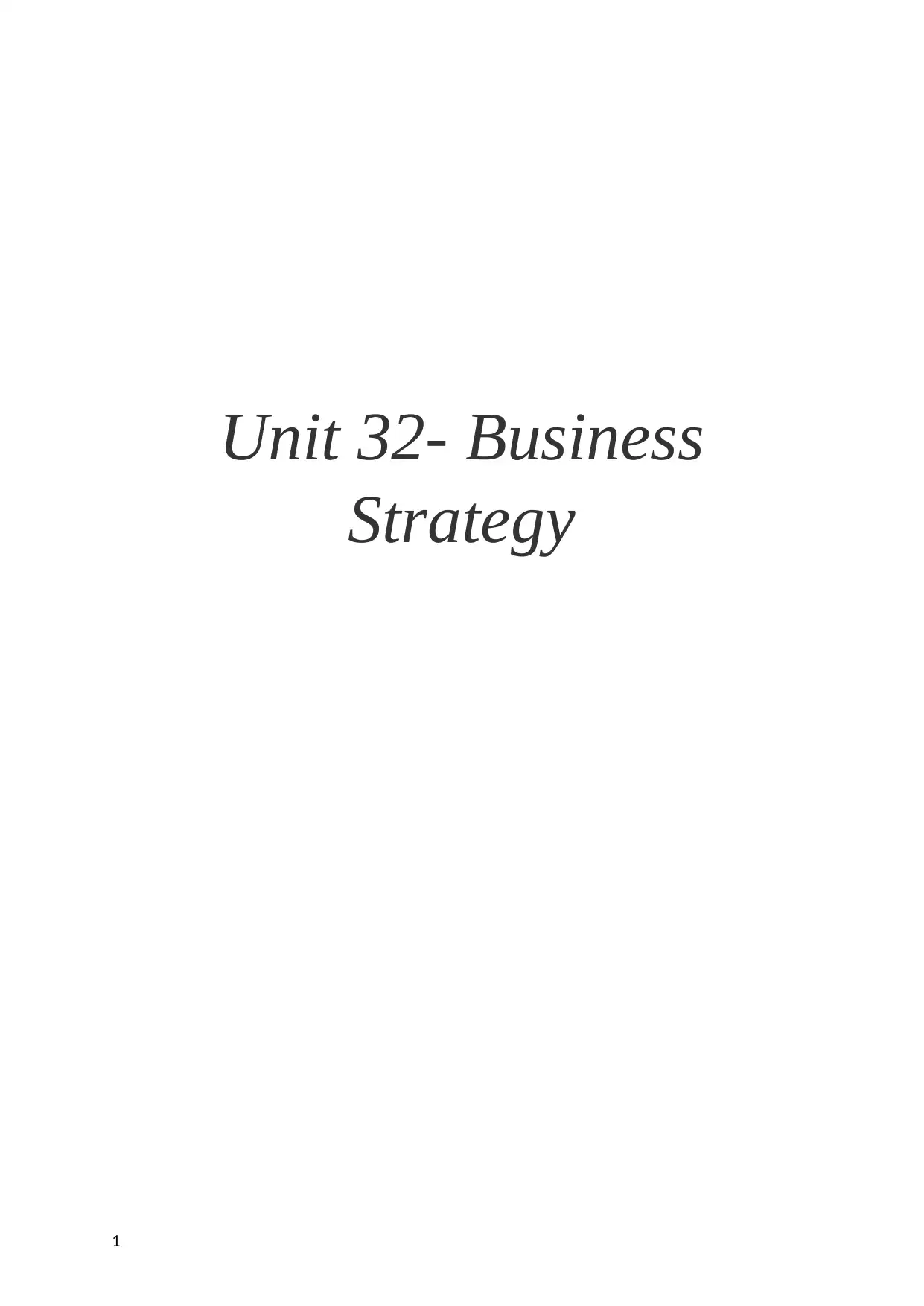
Unit 32- Business
Strategy
1
Strategy
1
Paraphrase This Document
Need a fresh take? Get an instant paraphrase of this document with our AI Paraphraser
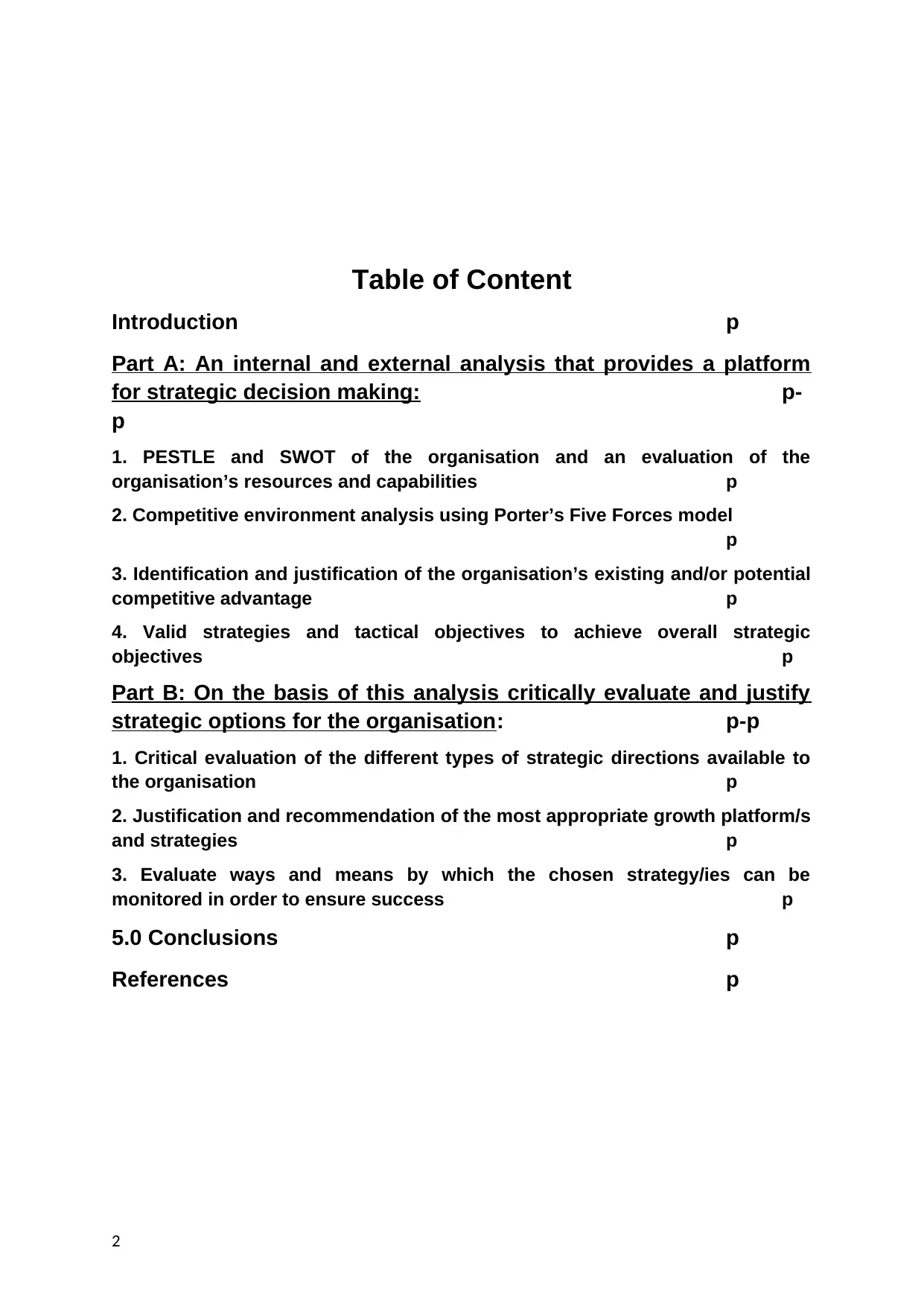
Table of Content
Introduction p
Part A: An internal and external analysis that provides a platform
for strategic decision making: p-
p
1. PESTLE and SWOT of the organisation and an evaluation of the
organisation’s resources and capabilities p
2. Competitive environment analysis using Porter’s Five Forces model
p
3. Identification and justification of the organisation’s existing and/or potential
competitive advantage p
4. Valid strategies and tactical objectives to achieve overall strategic
objectives p
Part B: On the basis of this analysis critically evaluate and justify
strategic options for the organisation: p-p
1. Critical evaluation of the different types of strategic directions available to
the organisation p
2. Justification and recommendation of the most appropriate growth platform/s
and strategies p
3. Evaluate ways and means by which the chosen strategy/ies can be
monitored in order to ensure success p
5.0 Conclusions p
References p
2
Introduction p
Part A: An internal and external analysis that provides a platform
for strategic decision making: p-
p
1. PESTLE and SWOT of the organisation and an evaluation of the
organisation’s resources and capabilities p
2. Competitive environment analysis using Porter’s Five Forces model
p
3. Identification and justification of the organisation’s existing and/or potential
competitive advantage p
4. Valid strategies and tactical objectives to achieve overall strategic
objectives p
Part B: On the basis of this analysis critically evaluate and justify
strategic options for the organisation: p-p
1. Critical evaluation of the different types of strategic directions available to
the organisation p
2. Justification and recommendation of the most appropriate growth platform/s
and strategies p
3. Evaluate ways and means by which the chosen strategy/ies can be
monitored in order to ensure success p
5.0 Conclusions p
References p
2
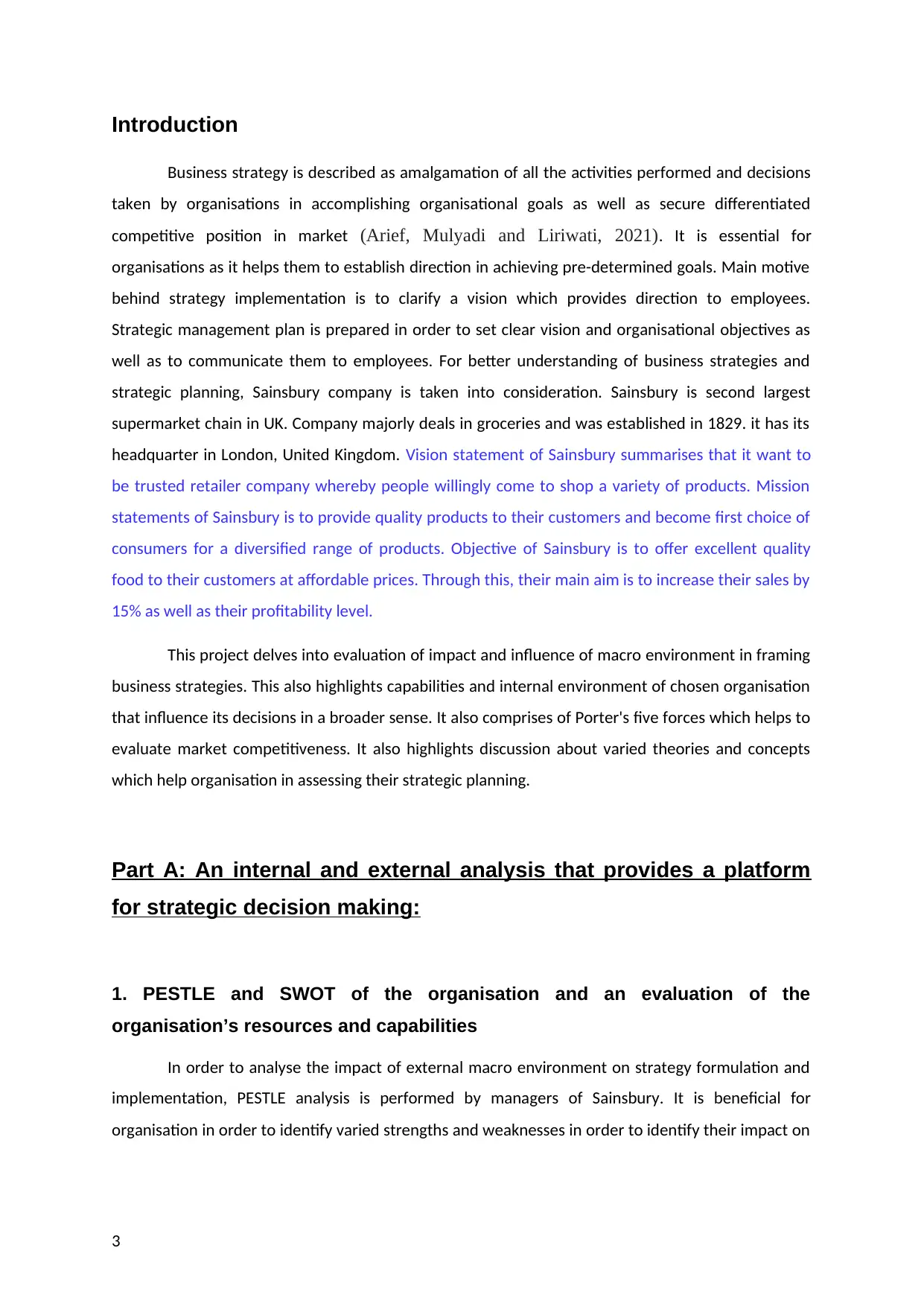
Introduction
Business strategy is described as amalgamation of all the activities performed and decisions
taken by organisations in accomplishing organisational goals as well as secure differentiated
competitive position in market (Arief, Mulyadi and Liriwati, 2021). It is essential for
organisations as it helps them to establish direction in achieving pre-determined goals. Main motive
behind strategy implementation is to clarify a vision which provides direction to employees.
Strategic management plan is prepared in order to set clear vision and organisational objectives as
well as to communicate them to employees. For better understanding of business strategies and
strategic planning, Sainsbury company is taken into consideration. Sainsbury is second largest
supermarket chain in UK. Company majorly deals in groceries and was established in 1829. it has its
headquarter in London, United Kingdom. Vision statement of Sainsbury summarises that it want to
be trusted retailer company whereby people willingly come to shop a variety of products. Mission
statements of Sainsbury is to provide quality products to their customers and become first choice of
consumers for a diversified range of products. Objective of Sainsbury is to offer excellent quality
food to their customers at affordable prices. Through this, their main aim is to increase their sales by
15% as well as their profitability level.
This project delves into evaluation of impact and influence of macro environment in framing
business strategies. This also highlights capabilities and internal environment of chosen organisation
that influence its decisions in a broader sense. It also comprises of Porter's five forces which helps to
evaluate market competitiveness. It also highlights discussion about varied theories and concepts
which help organisation in assessing their strategic planning.
Part A: An internal and external analysis that provides a platform
for strategic decision making:
1. PESTLE and SWOT of the organisation and an evaluation of the
organisation’s resources and capabilities
In order to analyse the impact of external macro environment on strategy formulation and
implementation, PESTLE analysis is performed by managers of Sainsbury. It is beneficial for
organisation in order to identify varied strengths and weaknesses in order to identify their impact on
3
Business strategy is described as amalgamation of all the activities performed and decisions
taken by organisations in accomplishing organisational goals as well as secure differentiated
competitive position in market (Arief, Mulyadi and Liriwati, 2021). It is essential for
organisations as it helps them to establish direction in achieving pre-determined goals. Main motive
behind strategy implementation is to clarify a vision which provides direction to employees.
Strategic management plan is prepared in order to set clear vision and organisational objectives as
well as to communicate them to employees. For better understanding of business strategies and
strategic planning, Sainsbury company is taken into consideration. Sainsbury is second largest
supermarket chain in UK. Company majorly deals in groceries and was established in 1829. it has its
headquarter in London, United Kingdom. Vision statement of Sainsbury summarises that it want to
be trusted retailer company whereby people willingly come to shop a variety of products. Mission
statements of Sainsbury is to provide quality products to their customers and become first choice of
consumers for a diversified range of products. Objective of Sainsbury is to offer excellent quality
food to their customers at affordable prices. Through this, their main aim is to increase their sales by
15% as well as their profitability level.
This project delves into evaluation of impact and influence of macro environment in framing
business strategies. This also highlights capabilities and internal environment of chosen organisation
that influence its decisions in a broader sense. It also comprises of Porter's five forces which helps to
evaluate market competitiveness. It also highlights discussion about varied theories and concepts
which help organisation in assessing their strategic planning.
Part A: An internal and external analysis that provides a platform
for strategic decision making:
1. PESTLE and SWOT of the organisation and an evaluation of the
organisation’s resources and capabilities
In order to analyse the impact of external macro environment on strategy formulation and
implementation, PESTLE analysis is performed by managers of Sainsbury. It is beneficial for
organisation in order to identify varied strengths and weaknesses in order to identify their impact on
3
⊘ This is a preview!⊘
Do you want full access?
Subscribe today to unlock all pages.

Trusted by 1+ million students worldwide
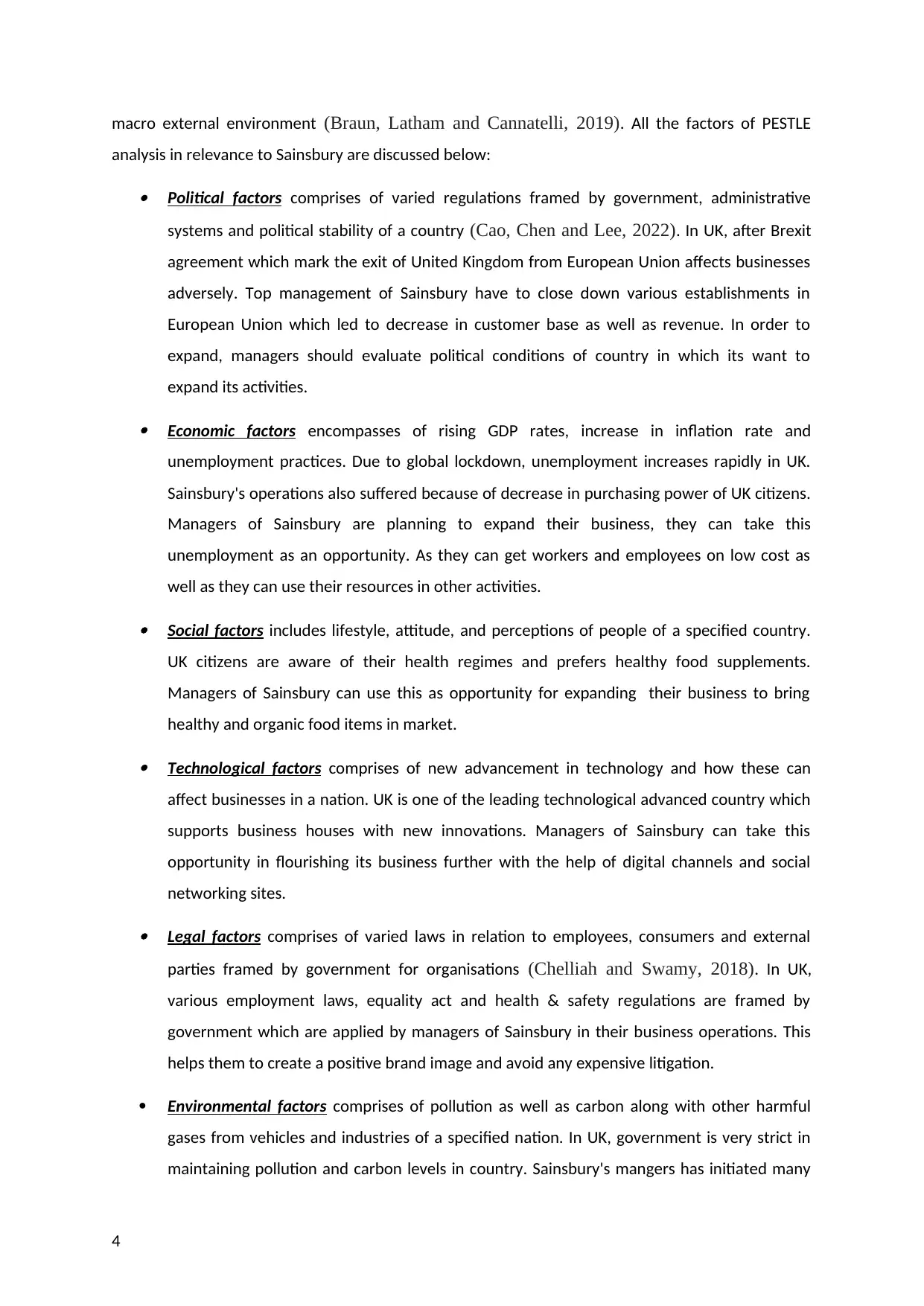
macro external environment (Braun, Latham and Cannatelli, 2019). All the factors of PESTLE
analysis in relevance to Sainsbury are discussed below: Political factors comprises of varied regulations framed by government, administrative
systems and political stability of a country (Cao, Chen and Lee, 2022). In UK, after Brexit
agreement which mark the exit of United Kingdom from European Union affects businesses
adversely. Top management of Sainsbury have to close down various establishments in
European Union which led to decrease in customer base as well as revenue. In order to
expand, managers should evaluate political conditions of country in which its want to
expand its activities. Economic factors encompasses of rising GDP rates, increase in inflation rate and
unemployment practices. Due to global lockdown, unemployment increases rapidly in UK.
Sainsbury's operations also suffered because of decrease in purchasing power of UK citizens.
Managers of Sainsbury are planning to expand their business, they can take this
unemployment as an opportunity. As they can get workers and employees on low cost as
well as they can use their resources in other activities. Social factors includes lifestyle, attitude, and perceptions of people of a specified country.
UK citizens are aware of their health regimes and prefers healthy food supplements.
Managers of Sainsbury can use this as opportunity for expanding their business to bring
healthy and organic food items in market. Technological factors comprises of new advancement in technology and how these can
affect businesses in a nation. UK is one of the leading technological advanced country which
supports business houses with new innovations. Managers of Sainsbury can take this
opportunity in flourishing its business further with the help of digital channels and social
networking sites. Legal factors comprises of varied laws in relation to employees, consumers and external
parties framed by government for organisations (Chelliah and Swamy, 2018). In UK,
various employment laws, equality act and health & safety regulations are framed by
government which are applied by managers of Sainsbury in their business operations. This
helps them to create a positive brand image and avoid any expensive litigation.
Environmental factors comprises of pollution as well as carbon along with other harmful
gases from vehicles and industries of a specified nation. In UK, government is very strict in
maintaining pollution and carbon levels in country. Sainsbury's mangers has initiated many
4
analysis in relevance to Sainsbury are discussed below: Political factors comprises of varied regulations framed by government, administrative
systems and political stability of a country (Cao, Chen and Lee, 2022). In UK, after Brexit
agreement which mark the exit of United Kingdom from European Union affects businesses
adversely. Top management of Sainsbury have to close down various establishments in
European Union which led to decrease in customer base as well as revenue. In order to
expand, managers should evaluate political conditions of country in which its want to
expand its activities. Economic factors encompasses of rising GDP rates, increase in inflation rate and
unemployment practices. Due to global lockdown, unemployment increases rapidly in UK.
Sainsbury's operations also suffered because of decrease in purchasing power of UK citizens.
Managers of Sainsbury are planning to expand their business, they can take this
unemployment as an opportunity. As they can get workers and employees on low cost as
well as they can use their resources in other activities. Social factors includes lifestyle, attitude, and perceptions of people of a specified country.
UK citizens are aware of their health regimes and prefers healthy food supplements.
Managers of Sainsbury can use this as opportunity for expanding their business to bring
healthy and organic food items in market. Technological factors comprises of new advancement in technology and how these can
affect businesses in a nation. UK is one of the leading technological advanced country which
supports business houses with new innovations. Managers of Sainsbury can take this
opportunity in flourishing its business further with the help of digital channels and social
networking sites. Legal factors comprises of varied laws in relation to employees, consumers and external
parties framed by government for organisations (Chelliah and Swamy, 2018). In UK,
various employment laws, equality act and health & safety regulations are framed by
government which are applied by managers of Sainsbury in their business operations. This
helps them to create a positive brand image and avoid any expensive litigation.
Environmental factors comprises of pollution as well as carbon along with other harmful
gases from vehicles and industries of a specified nation. In UK, government is very strict in
maintaining pollution and carbon levels in country. Sainsbury's mangers has initiated many
4
Paraphrase This Document
Need a fresh take? Get an instant paraphrase of this document with our AI Paraphraser
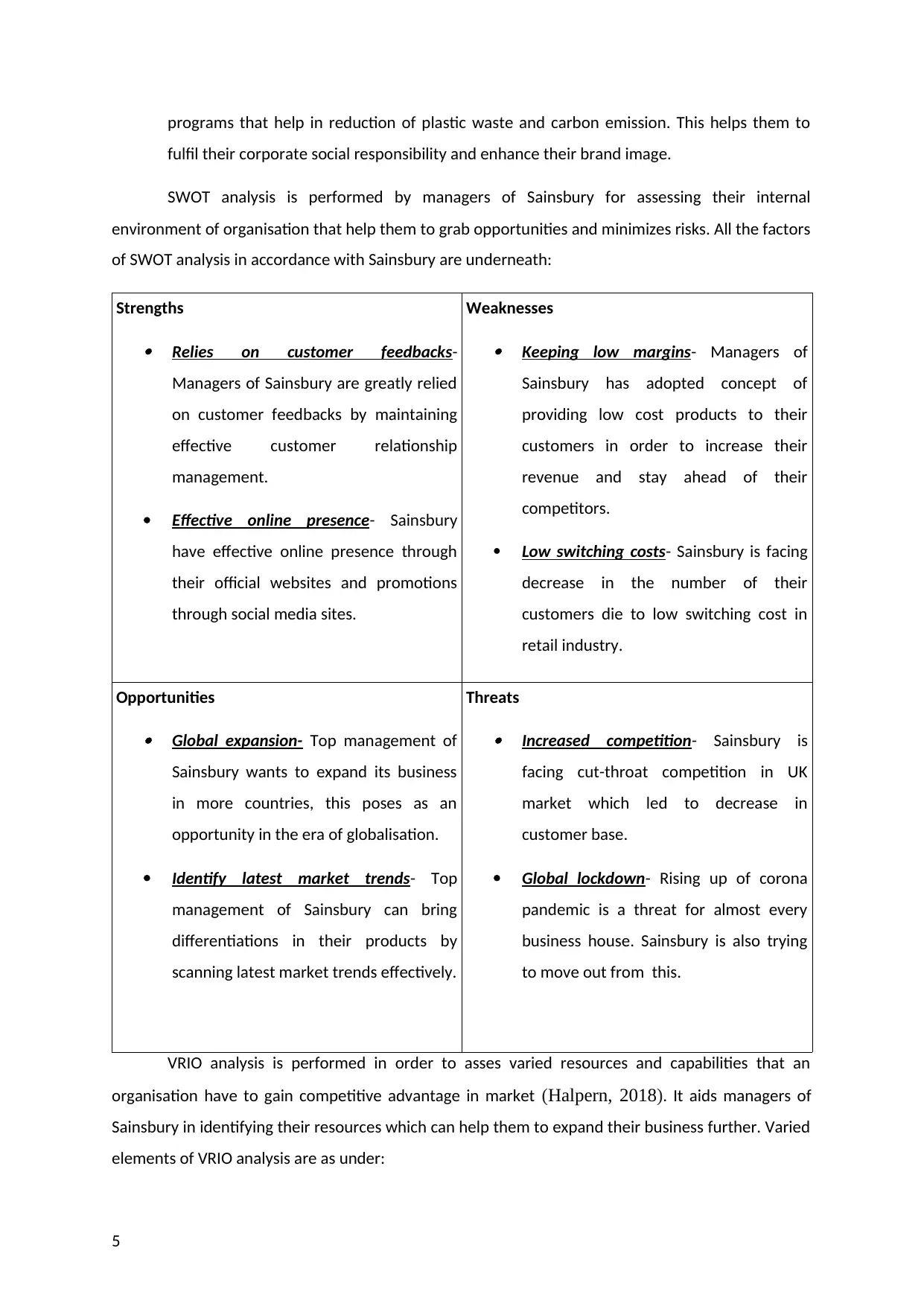
programs that help in reduction of plastic waste and carbon emission. This helps them to
fulfil their corporate social responsibility and enhance their brand image.
SWOT analysis is performed by managers of Sainsbury for assessing their internal
environment of organisation that help them to grab opportunities and minimizes risks. All the factors
of SWOT analysis in accordance with Sainsbury are underneath:
Strengths Relies on customer feedbacks-
Managers of Sainsbury are greatly relied
on customer feedbacks by maintaining
effective customer relationship
management.
Effective online presence- Sainsbury
have effective online presence through
their official websites and promotions
through social media sites.
Weaknesses
Keeping low margins- Managers of
Sainsbury has adopted concept of
providing low cost products to their
customers in order to increase their
revenue and stay ahead of their
competitors.
Low switching costs- Sainsbury is facing
decrease in the number of their
customers die to low switching cost in
retail industry.
Opportunities Global expansion- Top management of
Sainsbury wants to expand its business
in more countries, this poses as an
opportunity in the era of globalisation.
Identify latest market trends- Top
management of Sainsbury can bring
differentiations in their products by
scanning latest market trends effectively.
Threats
Increased competition- Sainsbury is
facing cut-throat competition in UK
market which led to decrease in
customer base.
Global lockdown- Rising up of corona
pandemic is a threat for almost every
business house. Sainsbury is also trying
to move out from this.
VRIO analysis is performed in order to asses varied resources and capabilities that an
organisation have to gain competitive advantage in market (Halpern, 2018). It aids managers of
Sainsbury in identifying their resources which can help them to expand their business further. Varied
elements of VRIO analysis are as under:
5
fulfil their corporate social responsibility and enhance their brand image.
SWOT analysis is performed by managers of Sainsbury for assessing their internal
environment of organisation that help them to grab opportunities and minimizes risks. All the factors
of SWOT analysis in accordance with Sainsbury are underneath:
Strengths Relies on customer feedbacks-
Managers of Sainsbury are greatly relied
on customer feedbacks by maintaining
effective customer relationship
management.
Effective online presence- Sainsbury
have effective online presence through
their official websites and promotions
through social media sites.
Weaknesses
Keeping low margins- Managers of
Sainsbury has adopted concept of
providing low cost products to their
customers in order to increase their
revenue and stay ahead of their
competitors.
Low switching costs- Sainsbury is facing
decrease in the number of their
customers die to low switching cost in
retail industry.
Opportunities Global expansion- Top management of
Sainsbury wants to expand its business
in more countries, this poses as an
opportunity in the era of globalisation.
Identify latest market trends- Top
management of Sainsbury can bring
differentiations in their products by
scanning latest market trends effectively.
Threats
Increased competition- Sainsbury is
facing cut-throat competition in UK
market which led to decrease in
customer base.
Global lockdown- Rising up of corona
pandemic is a threat for almost every
business house. Sainsbury is also trying
to move out from this.
VRIO analysis is performed in order to asses varied resources and capabilities that an
organisation have to gain competitive advantage in market (Halpern, 2018). It aids managers of
Sainsbury in identifying their resources which can help them to expand their business further. Varied
elements of VRIO analysis are as under:
5
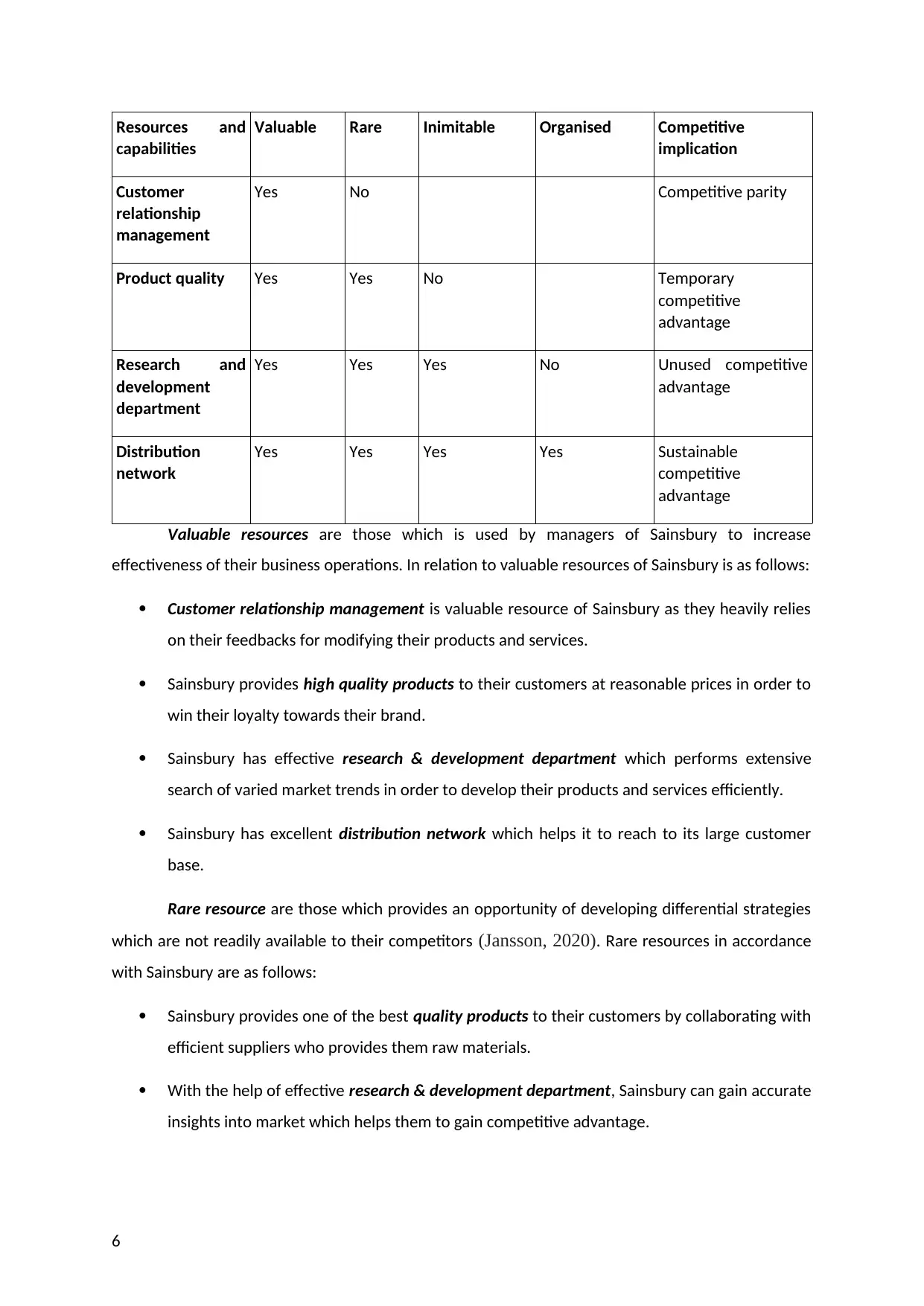
Resources and
capabilities
Valuable Rare Inimitable Organised Competitive
implication
Customer
relationship
management
Yes No Competitive parity
Product quality Yes Yes No Temporary
competitive
advantage
Research and
development
department
Yes Yes Yes No Unused competitive
advantage
Distribution
network
Yes Yes Yes Yes Sustainable
competitive
advantage
Valuable resources are those which is used by managers of Sainsbury to increase
effectiveness of their business operations. In relation to valuable resources of Sainsbury is as follows:
Customer relationship management is valuable resource of Sainsbury as they heavily relies
on their feedbacks for modifying their products and services.
Sainsbury provides high quality products to their customers at reasonable prices in order to
win their loyalty towards their brand.
Sainsbury has effective research & development department which performs extensive
search of varied market trends in order to develop their products and services efficiently.
Sainsbury has excellent distribution network which helps it to reach to its large customer
base.
Rare resource are those which provides an opportunity of developing differential strategies
which are not readily available to their competitors (Jansson, 2020). Rare resources in accordance
with Sainsbury are as follows:
Sainsbury provides one of the best quality products to their customers by collaborating with
efficient suppliers who provides them raw materials.
With the help of effective research & development department, Sainsbury can gain accurate
insights into market which helps them to gain competitive advantage.
6
capabilities
Valuable Rare Inimitable Organised Competitive
implication
Customer
relationship
management
Yes No Competitive parity
Product quality Yes Yes No Temporary
competitive
advantage
Research and
development
department
Yes Yes Yes No Unused competitive
advantage
Distribution
network
Yes Yes Yes Yes Sustainable
competitive
advantage
Valuable resources are those which is used by managers of Sainsbury to increase
effectiveness of their business operations. In relation to valuable resources of Sainsbury is as follows:
Customer relationship management is valuable resource of Sainsbury as they heavily relies
on their feedbacks for modifying their products and services.
Sainsbury provides high quality products to their customers at reasonable prices in order to
win their loyalty towards their brand.
Sainsbury has effective research & development department which performs extensive
search of varied market trends in order to develop their products and services efficiently.
Sainsbury has excellent distribution network which helps it to reach to its large customer
base.
Rare resource are those which provides an opportunity of developing differential strategies
which are not readily available to their competitors (Jansson, 2020). Rare resources in accordance
with Sainsbury are as follows:
Sainsbury provides one of the best quality products to their customers by collaborating with
efficient suppliers who provides them raw materials.
With the help of effective research & development department, Sainsbury can gain accurate
insights into market which helps them to gain competitive advantage.
6
⊘ This is a preview!⊘
Do you want full access?
Subscribe today to unlock all pages.

Trusted by 1+ million students worldwide
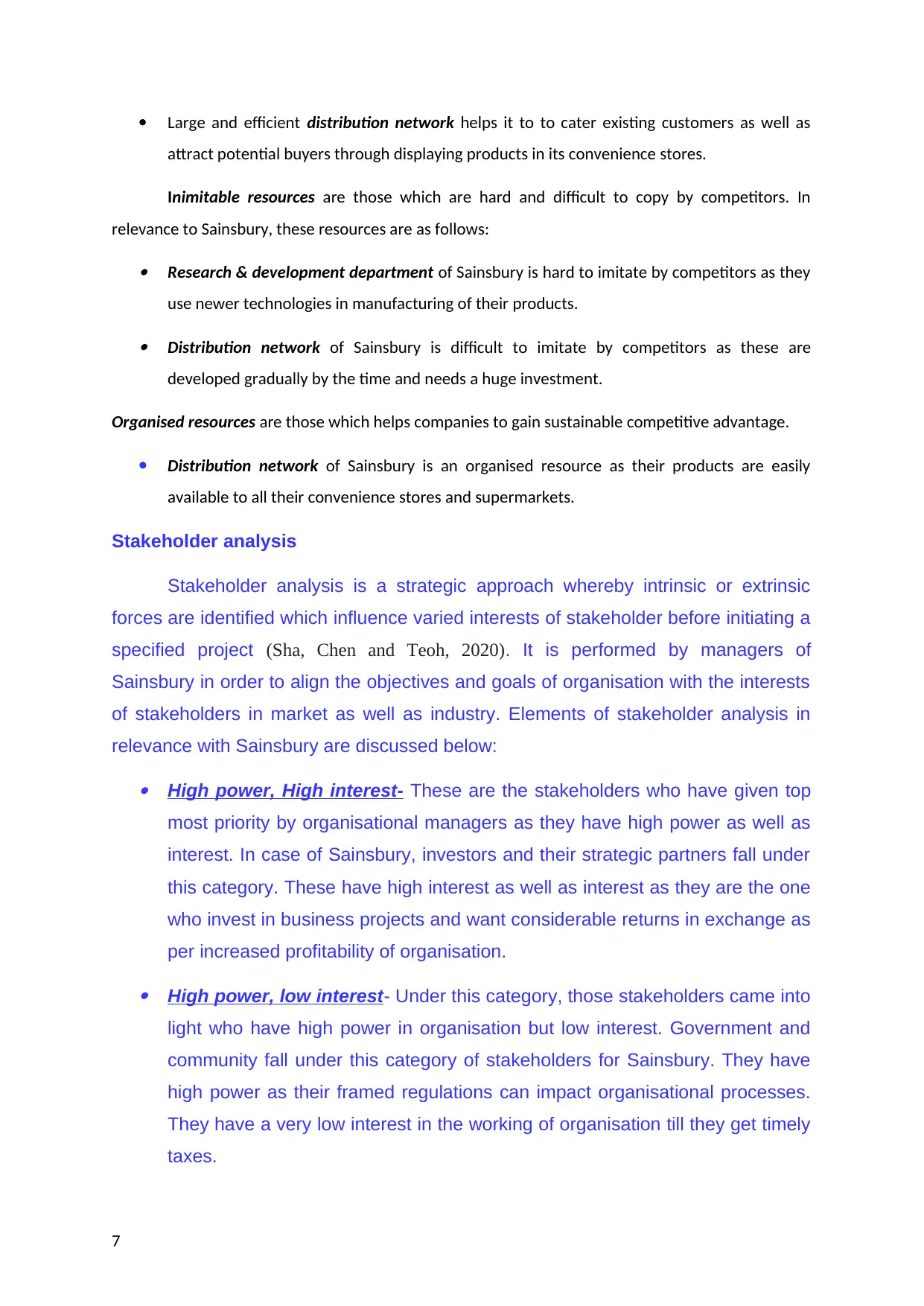
Large and efficient distribution network helps it to to cater existing customers as well as
attract potential buyers through displaying products in its convenience stores.
Inimitable resources are those which are hard and difficult to copy by competitors. In
relevance to Sainsbury, these resources are as follows: Research & development department of Sainsbury is hard to imitate by competitors as they
use newer technologies in manufacturing of their products. Distribution network of Sainsbury is difficult to imitate by competitors as these are
developed gradually by the time and needs a huge investment.
Organised resources are those which helps companies to gain sustainable competitive advantage.
Distribution network of Sainsbury is an organised resource as their products are easily
available to all their convenience stores and supermarkets.
Stakeholder analysis
Stakeholder analysis is a strategic approach whereby intrinsic or extrinsic
forces are identified which influence varied interests of stakeholder before initiating a
specified project (Sha, Chen and Teoh, 2020). It is performed by managers of
Sainsbury in order to align the objectives and goals of organisation with the interests
of stakeholders in market as well as industry. Elements of stakeholder analysis in
relevance with Sainsbury are discussed below: High power, High interest- These are the stakeholders who have given top
most priority by organisational managers as they have high power as well as
interest. In case of Sainsbury, investors and their strategic partners fall under
this category. These have high interest as well as interest as they are the one
who invest in business projects and want considerable returns in exchange as
per increased profitability of organisation. High power, low interest- Under this category, those stakeholders came into
light who have high power in organisation but low interest. Government and
community fall under this category of stakeholders for Sainsbury. They have
high power as their framed regulations can impact organisational processes.
They have a very low interest in the working of organisation till they get timely
taxes.
7
attract potential buyers through displaying products in its convenience stores.
Inimitable resources are those which are hard and difficult to copy by competitors. In
relevance to Sainsbury, these resources are as follows: Research & development department of Sainsbury is hard to imitate by competitors as they
use newer technologies in manufacturing of their products. Distribution network of Sainsbury is difficult to imitate by competitors as these are
developed gradually by the time and needs a huge investment.
Organised resources are those which helps companies to gain sustainable competitive advantage.
Distribution network of Sainsbury is an organised resource as their products are easily
available to all their convenience stores and supermarkets.
Stakeholder analysis
Stakeholder analysis is a strategic approach whereby intrinsic or extrinsic
forces are identified which influence varied interests of stakeholder before initiating a
specified project (Sha, Chen and Teoh, 2020). It is performed by managers of
Sainsbury in order to align the objectives and goals of organisation with the interests
of stakeholders in market as well as industry. Elements of stakeholder analysis in
relevance with Sainsbury are discussed below: High power, High interest- These are the stakeholders who have given top
most priority by organisational managers as they have high power as well as
interest. In case of Sainsbury, investors and their strategic partners fall under
this category. These have high interest as well as interest as they are the one
who invest in business projects and want considerable returns in exchange as
per increased profitability of organisation. High power, low interest- Under this category, those stakeholders came into
light who have high power in organisation but low interest. Government and
community fall under this category of stakeholders for Sainsbury. They have
high power as their framed regulations can impact organisational processes.
They have a very low interest in the working of organisation till they get timely
taxes.
7
Paraphrase This Document
Need a fresh take? Get an instant paraphrase of this document with our AI Paraphraser
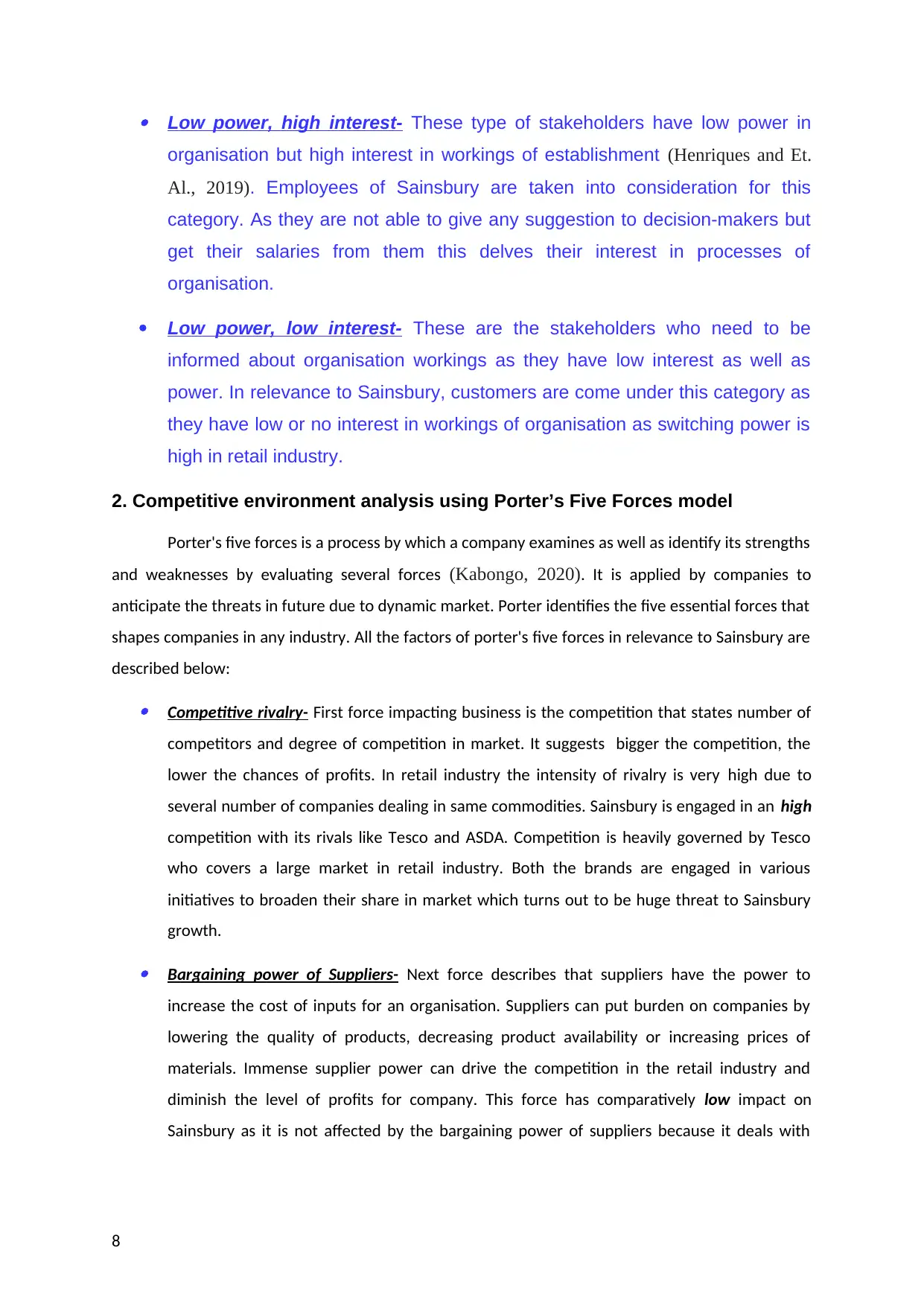
Low power, high interest- These type of stakeholders have low power in
organisation but high interest in workings of establishment (Henriques and Et.
Al., 2019). Employees of Sainsbury are taken into consideration for this
category. As they are not able to give any suggestion to decision-makers but
get their salaries from them this delves their interest in processes of
organisation.
Low power, low interest- These are the stakeholders who need to be
informed about organisation workings as they have low interest as well as
power. In relevance to Sainsbury, customers are come under this category as
they have low or no interest in workings of organisation as switching power is
high in retail industry.
2. Competitive environment analysis using Porter’s Five Forces model
Porter's five forces is a process by which a company examines as well as identify its strengths
and weaknesses by evaluating several forces (Kabongo, 2020). It is applied by companies to
anticipate the threats in future due to dynamic market. Porter identifies the five essential forces that
shapes companies in any industry. All the factors of porter's five forces in relevance to Sainsbury are
described below: Competitive rivalry- First force impacting business is the competition that states number of
competitors and degree of competition in market. It suggests bigger the competition, the
lower the chances of profits. In retail industry the intensity of rivalry is very high due to
several number of companies dealing in same commodities. Sainsbury is engaged in an high
competition with its rivals like Tesco and ASDA. Competition is heavily governed by Tesco
who covers a large market in retail industry. Both the brands are engaged in various
initiatives to broaden their share in market which turns out to be huge threat to Sainsbury
growth. Bargaining power of Suppliers- Next force describes that suppliers have the power to
increase the cost of inputs for an organisation. Suppliers can put burden on companies by
lowering the quality of products, decreasing product availability or increasing prices of
materials. Immense supplier power can drive the competition in the retail industry and
diminish the level of profits for company. This force has comparatively low impact on
Sainsbury as it is not affected by the bargaining power of suppliers because it deals with
8
organisation but high interest in workings of establishment (Henriques and Et.
Al., 2019). Employees of Sainsbury are taken into consideration for this
category. As they are not able to give any suggestion to decision-makers but
get their salaries from them this delves their interest in processes of
organisation.
Low power, low interest- These are the stakeholders who need to be
informed about organisation workings as they have low interest as well as
power. In relevance to Sainsbury, customers are come under this category as
they have low or no interest in workings of organisation as switching power is
high in retail industry.
2. Competitive environment analysis using Porter’s Five Forces model
Porter's five forces is a process by which a company examines as well as identify its strengths
and weaknesses by evaluating several forces (Kabongo, 2020). It is applied by companies to
anticipate the threats in future due to dynamic market. Porter identifies the five essential forces that
shapes companies in any industry. All the factors of porter's five forces in relevance to Sainsbury are
described below: Competitive rivalry- First force impacting business is the competition that states number of
competitors and degree of competition in market. It suggests bigger the competition, the
lower the chances of profits. In retail industry the intensity of rivalry is very high due to
several number of companies dealing in same commodities. Sainsbury is engaged in an high
competition with its rivals like Tesco and ASDA. Competition is heavily governed by Tesco
who covers a large market in retail industry. Both the brands are engaged in various
initiatives to broaden their share in market which turns out to be huge threat to Sainsbury
growth. Bargaining power of Suppliers- Next force describes that suppliers have the power to
increase the cost of inputs for an organisation. Suppliers can put burden on companies by
lowering the quality of products, decreasing product availability or increasing prices of
materials. Immense supplier power can drive the competition in the retail industry and
diminish the level of profits for company. This force has comparatively low impact on
Sainsbury as it is not affected by the bargaining power of suppliers because it deals with
8
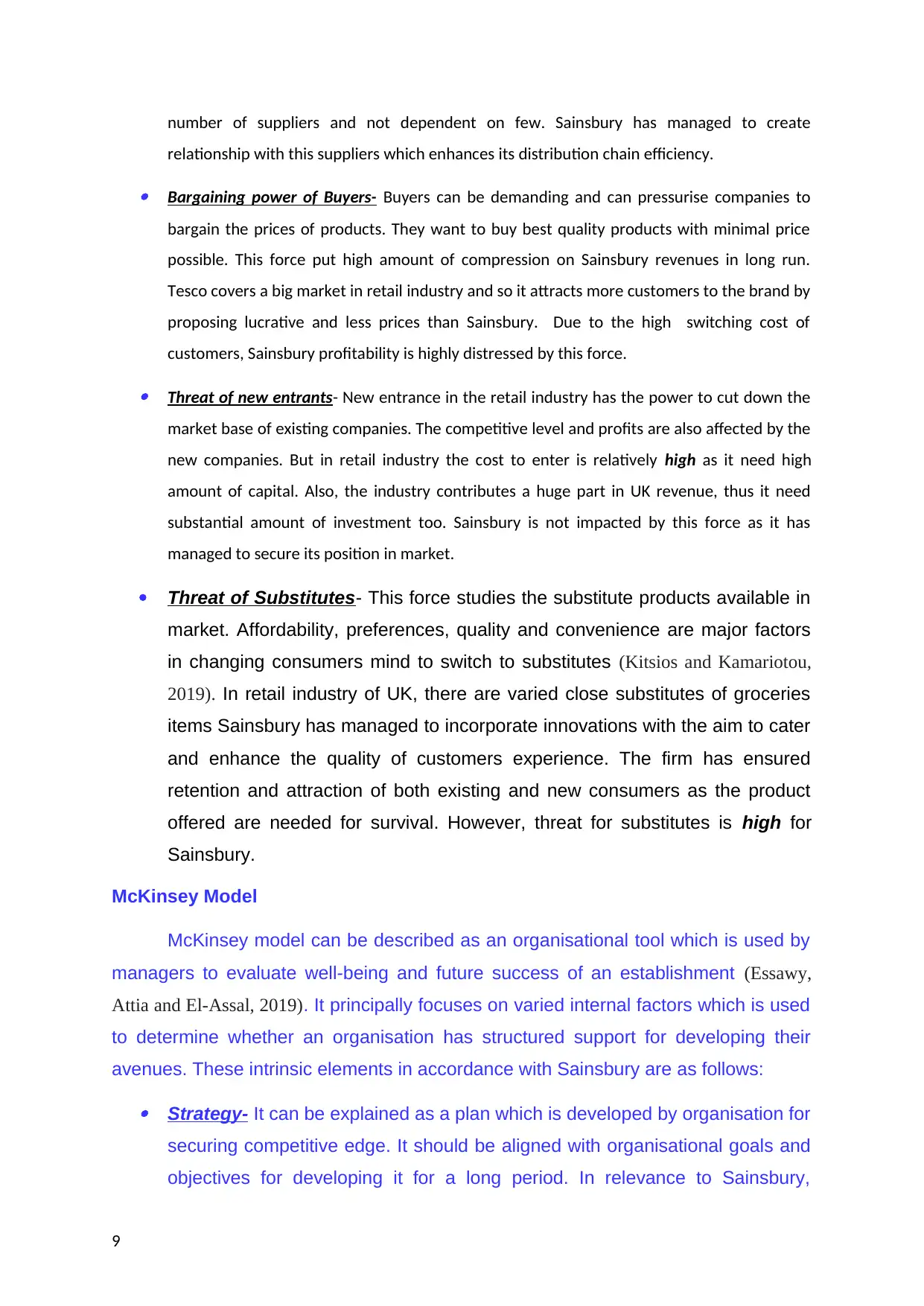
number of suppliers and not dependent on few. Sainsbury has managed to create
relationship with this suppliers which enhances its distribution chain efficiency. Bargaining power of Buyers- Buyers can be demanding and can pressurise companies to
bargain the prices of products. They want to buy best quality products with minimal price
possible. This force put high amount of compression on Sainsbury revenues in long run.
Tesco covers a big market in retail industry and so it attracts more customers to the brand by
proposing lucrative and less prices than Sainsbury. Due to the high switching cost of
customers, Sainsbury profitability is highly distressed by this force. Threat of new entrants- New entrance in the retail industry has the power to cut down the
market base of existing companies. The competitive level and profits are also affected by the
new companies. But in retail industry the cost to enter is relatively high as it need high
amount of capital. Also, the industry contributes a huge part in UK revenue, thus it need
substantial amount of investment too. Sainsbury is not impacted by this force as it has
managed to secure its position in market.
Threat of Substitutes- This force studies the substitute products available in
market. Affordability, preferences, quality and convenience are major factors
in changing consumers mind to switch to substitutes (Kitsios and Kamariotou,
2019). In retail industry of UK, there are varied close substitutes of groceries
items Sainsbury has managed to incorporate innovations with the aim to cater
and enhance the quality of customers experience. The firm has ensured
retention and attraction of both existing and new consumers as the product
offered are needed for survival. However, threat for substitutes is high for
Sainsbury.
McKinsey Model
McKinsey model can be described as an organisational tool which is used by
managers to evaluate well-being and future success of an establishment (Essawy,
Attia and El-Assal, 2019). It principally focuses on varied internal factors which is used
to determine whether an organisation has structured support for developing their
avenues. These intrinsic elements in accordance with Sainsbury are as follows: Strategy- It can be explained as a plan which is developed by organisation for
securing competitive edge. It should be aligned with organisational goals and
objectives for developing it for a long period. In relevance to Sainsbury,
9
relationship with this suppliers which enhances its distribution chain efficiency. Bargaining power of Buyers- Buyers can be demanding and can pressurise companies to
bargain the prices of products. They want to buy best quality products with minimal price
possible. This force put high amount of compression on Sainsbury revenues in long run.
Tesco covers a big market in retail industry and so it attracts more customers to the brand by
proposing lucrative and less prices than Sainsbury. Due to the high switching cost of
customers, Sainsbury profitability is highly distressed by this force. Threat of new entrants- New entrance in the retail industry has the power to cut down the
market base of existing companies. The competitive level and profits are also affected by the
new companies. But in retail industry the cost to enter is relatively high as it need high
amount of capital. Also, the industry contributes a huge part in UK revenue, thus it need
substantial amount of investment too. Sainsbury is not impacted by this force as it has
managed to secure its position in market.
Threat of Substitutes- This force studies the substitute products available in
market. Affordability, preferences, quality and convenience are major factors
in changing consumers mind to switch to substitutes (Kitsios and Kamariotou,
2019). In retail industry of UK, there are varied close substitutes of groceries
items Sainsbury has managed to incorporate innovations with the aim to cater
and enhance the quality of customers experience. The firm has ensured
retention and attraction of both existing and new consumers as the product
offered are needed for survival. However, threat for substitutes is high for
Sainsbury.
McKinsey Model
McKinsey model can be described as an organisational tool which is used by
managers to evaluate well-being and future success of an establishment (Essawy,
Attia and El-Assal, 2019). It principally focuses on varied internal factors which is used
to determine whether an organisation has structured support for developing their
avenues. These intrinsic elements in accordance with Sainsbury are as follows: Strategy- It can be explained as a plan which is developed by organisation for
securing competitive edge. It should be aligned with organisational goals and
objectives for developing it for a long period. In relevance to Sainsbury,
9
⊘ This is a preview!⊘
Do you want full access?
Subscribe today to unlock all pages.

Trusted by 1+ million students worldwide
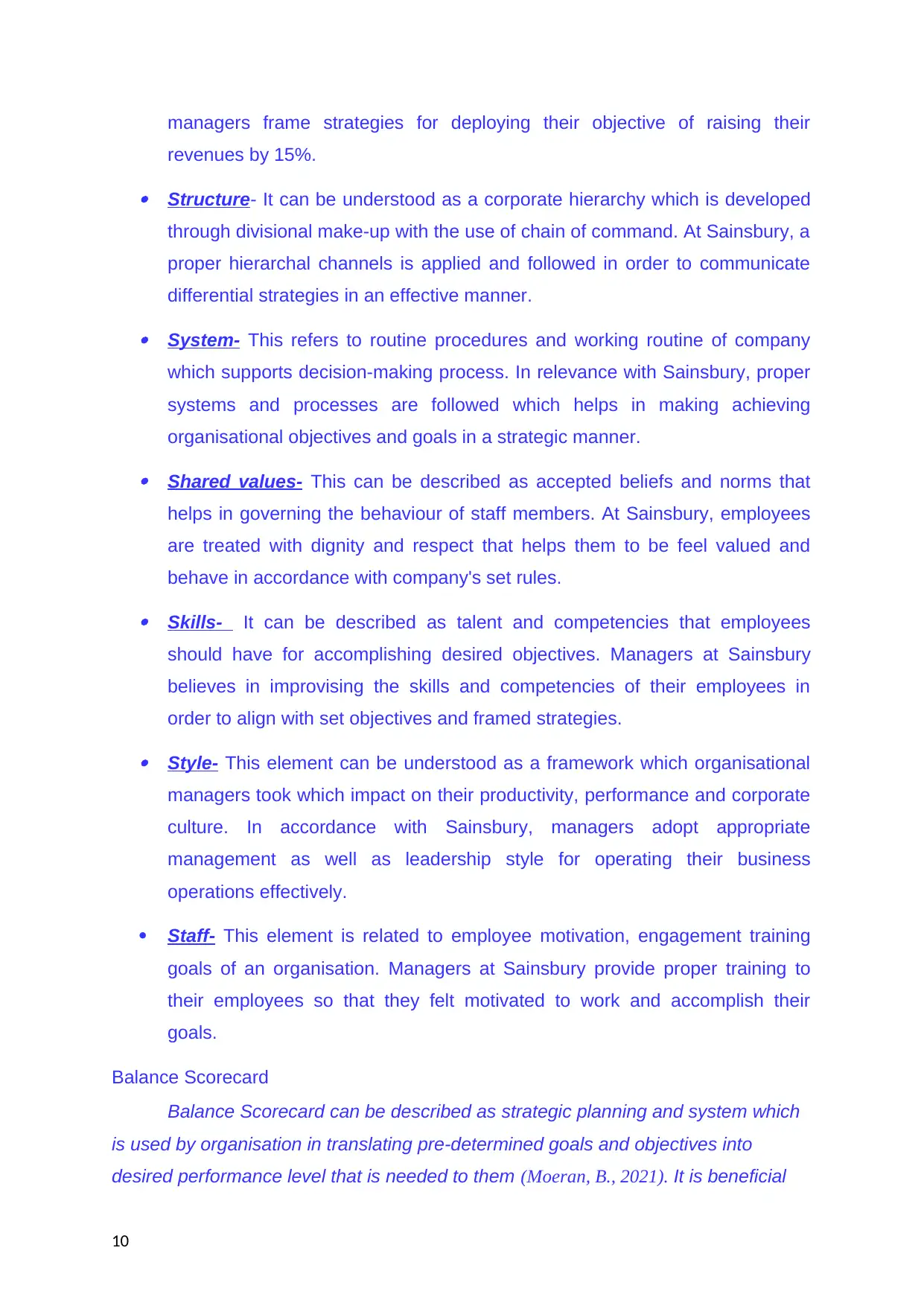
managers frame strategies for deploying their objective of raising their
revenues by 15%. Structure- It can be understood as a corporate hierarchy which is developed
through divisional make-up with the use of chain of command. At Sainsbury, a
proper hierarchal channels is applied and followed in order to communicate
differential strategies in an effective manner. System- This refers to routine procedures and working routine of company
which supports decision-making process. In relevance with Sainsbury, proper
systems and processes are followed which helps in making achieving
organisational objectives and goals in a strategic manner. Shared values- This can be described as accepted beliefs and norms that
helps in governing the behaviour of staff members. At Sainsbury, employees
are treated with dignity and respect that helps them to be feel valued and
behave in accordance with company's set rules. Skills- It can be described as talent and competencies that employees
should have for accomplishing desired objectives. Managers at Sainsbury
believes in improvising the skills and competencies of their employees in
order to align with set objectives and framed strategies. Style- This element can be understood as a framework which organisational
managers took which impact on their productivity, performance and corporate
culture. In accordance with Sainsbury, managers adopt appropriate
management as well as leadership style for operating their business
operations effectively.
Staff- This element is related to employee motivation, engagement training
goals of an organisation. Managers at Sainsbury provide proper training to
their employees so that they felt motivated to work and accomplish their
goals.
Balance Scorecard
Balance Scorecard can be described as strategic planning and system which
is used by organisation in translating pre-determined goals and objectives into
desired performance level that is needed to them (Moeran, B., 2021). It is beneficial
10
revenues by 15%. Structure- It can be understood as a corporate hierarchy which is developed
through divisional make-up with the use of chain of command. At Sainsbury, a
proper hierarchal channels is applied and followed in order to communicate
differential strategies in an effective manner. System- This refers to routine procedures and working routine of company
which supports decision-making process. In relevance with Sainsbury, proper
systems and processes are followed which helps in making achieving
organisational objectives and goals in a strategic manner. Shared values- This can be described as accepted beliefs and norms that
helps in governing the behaviour of staff members. At Sainsbury, employees
are treated with dignity and respect that helps them to be feel valued and
behave in accordance with company's set rules. Skills- It can be described as talent and competencies that employees
should have for accomplishing desired objectives. Managers at Sainsbury
believes in improvising the skills and competencies of their employees in
order to align with set objectives and framed strategies. Style- This element can be understood as a framework which organisational
managers took which impact on their productivity, performance and corporate
culture. In accordance with Sainsbury, managers adopt appropriate
management as well as leadership style for operating their business
operations effectively.
Staff- This element is related to employee motivation, engagement training
goals of an organisation. Managers at Sainsbury provide proper training to
their employees so that they felt motivated to work and accomplish their
goals.
Balance Scorecard
Balance Scorecard can be described as strategic planning and system which
is used by organisation in translating pre-determined goals and objectives into
desired performance level that is needed to them (Moeran, B., 2021). It is beneficial
10
Paraphrase This Document
Need a fresh take? Get an instant paraphrase of this document with our AI Paraphraser
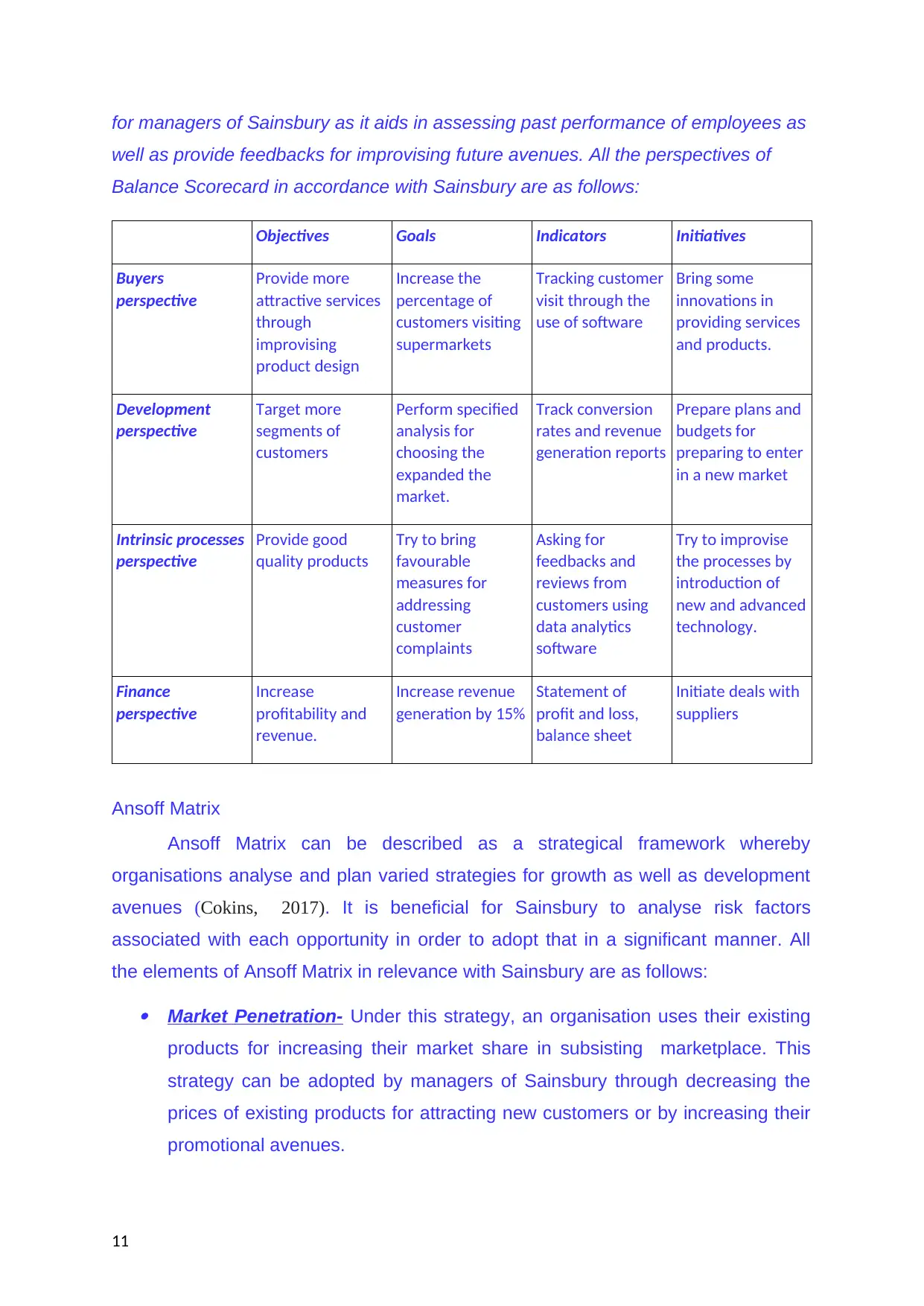
for managers of Sainsbury as it aids in assessing past performance of employees as
well as provide feedbacks for improvising future avenues. All the perspectives of
Balance Scorecard in accordance with Sainsbury are as follows:
Objectives Goals Indicators Initiatives
Buyers
perspective
Provide more
attractive services
through
improvising
product design
Increase the
percentage of
customers visiting
supermarkets
Tracking customer
visit through the
use of software
Bring some
innovations in
providing services
and products.
Development
perspective
Target more
segments of
customers
Perform specified
analysis for
choosing the
expanded the
market.
Track conversion
rates and revenue
generation reports
Prepare plans and
budgets for
preparing to enter
in a new market
Intrinsic processes
perspective
Provide good
quality products
Try to bring
favourable
measures for
addressing
customer
complaints
Asking for
feedbacks and
reviews from
customers using
data analytics
software
Try to improvise
the processes by
introduction of
new and advanced
technology.
Finance
perspective
Increase
profitability and
revenue.
Increase revenue
generation by 15%
Statement of
profit and loss,
balance sheet
Initiate deals with
suppliers
Ansoff Matrix
Ansoff Matrix can be described as a strategical framework whereby
organisations analyse and plan varied strategies for growth as well as development
avenues (Cokins, 2017). It is beneficial for Sainsbury to analyse risk factors
associated with each opportunity in order to adopt that in a significant manner. All
the elements of Ansoff Matrix in relevance with Sainsbury are as follows: Market Penetration- Under this strategy, an organisation uses their existing
products for increasing their market share in subsisting marketplace. This
strategy can be adopted by managers of Sainsbury through decreasing the
prices of existing products for attracting new customers or by increasing their
promotional avenues.
11
well as provide feedbacks for improvising future avenues. All the perspectives of
Balance Scorecard in accordance with Sainsbury are as follows:
Objectives Goals Indicators Initiatives
Buyers
perspective
Provide more
attractive services
through
improvising
product design
Increase the
percentage of
customers visiting
supermarkets
Tracking customer
visit through the
use of software
Bring some
innovations in
providing services
and products.
Development
perspective
Target more
segments of
customers
Perform specified
analysis for
choosing the
expanded the
market.
Track conversion
rates and revenue
generation reports
Prepare plans and
budgets for
preparing to enter
in a new market
Intrinsic processes
perspective
Provide good
quality products
Try to bring
favourable
measures for
addressing
customer
complaints
Asking for
feedbacks and
reviews from
customers using
data analytics
software
Try to improvise
the processes by
introduction of
new and advanced
technology.
Finance
perspective
Increase
profitability and
revenue.
Increase revenue
generation by 15%
Statement of
profit and loss,
balance sheet
Initiate deals with
suppliers
Ansoff Matrix
Ansoff Matrix can be described as a strategical framework whereby
organisations analyse and plan varied strategies for growth as well as development
avenues (Cokins, 2017). It is beneficial for Sainsbury to analyse risk factors
associated with each opportunity in order to adopt that in a significant manner. All
the elements of Ansoff Matrix in relevance with Sainsbury are as follows: Market Penetration- Under this strategy, an organisation uses their existing
products for increasing their market share in subsisting marketplace. This
strategy can be adopted by managers of Sainsbury through decreasing the
prices of existing products for attracting new customers or by increasing their
promotional avenues.
11
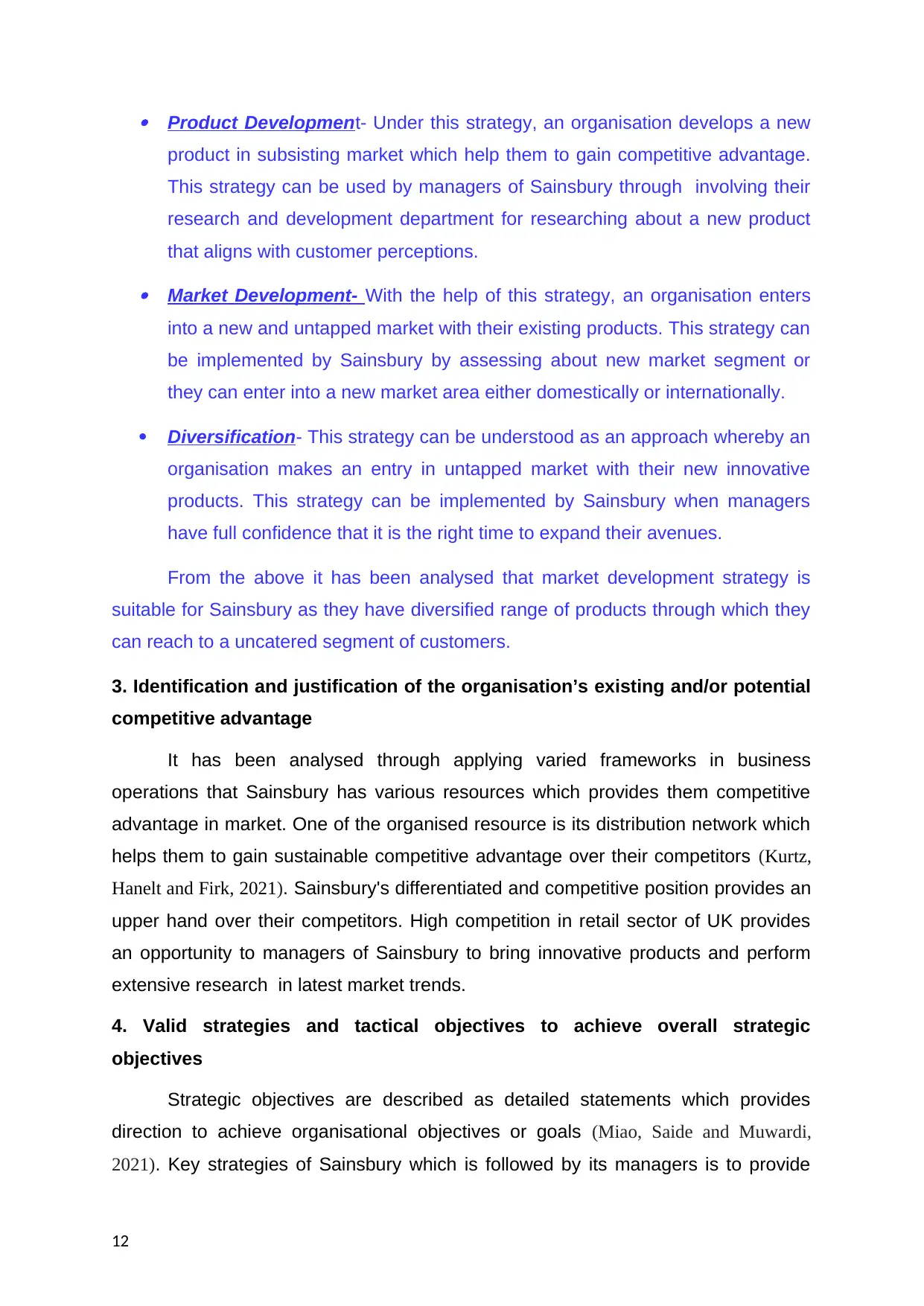
Product Development- Under this strategy, an organisation develops a new
product in subsisting market which help them to gain competitive advantage.
This strategy can be used by managers of Sainsbury through involving their
research and development department for researching about a new product
that aligns with customer perceptions. Market Development- With the help of this strategy, an organisation enters
into a new and untapped market with their existing products. This strategy can
be implemented by Sainsbury by assessing about new market segment or
they can enter into a new market area either domestically or internationally.
Diversification- This strategy can be understood as an approach whereby an
organisation makes an entry in untapped market with their new innovative
products. This strategy can be implemented by Sainsbury when managers
have full confidence that it is the right time to expand their avenues.
From the above it has been analysed that market development strategy is
suitable for Sainsbury as they have diversified range of products through which they
can reach to a uncatered segment of customers.
3. Identification and justification of the organisation’s existing and/or potential
competitive advantage
It has been analysed through applying varied frameworks in business
operations that Sainsbury has various resources which provides them competitive
advantage in market. One of the organised resource is its distribution network which
helps them to gain sustainable competitive advantage over their competitors (Kurtz,
Hanelt and Firk, 2021). Sainsbury's differentiated and competitive position provides an
upper hand over their competitors. High competition in retail sector of UK provides
an opportunity to managers of Sainsbury to bring innovative products and perform
extensive research in latest market trends.
4. Valid strategies and tactical objectives to achieve overall strategic
objectives
Strategic objectives are described as detailed statements which provides
direction to achieve organisational objectives or goals (Miao, Saide and Muwardi,
2021). Key strategies of Sainsbury which is followed by its managers is to provide
12
product in subsisting market which help them to gain competitive advantage.
This strategy can be used by managers of Sainsbury through involving their
research and development department for researching about a new product
that aligns with customer perceptions. Market Development- With the help of this strategy, an organisation enters
into a new and untapped market with their existing products. This strategy can
be implemented by Sainsbury by assessing about new market segment or
they can enter into a new market area either domestically or internationally.
Diversification- This strategy can be understood as an approach whereby an
organisation makes an entry in untapped market with their new innovative
products. This strategy can be implemented by Sainsbury when managers
have full confidence that it is the right time to expand their avenues.
From the above it has been analysed that market development strategy is
suitable for Sainsbury as they have diversified range of products through which they
can reach to a uncatered segment of customers.
3. Identification and justification of the organisation’s existing and/or potential
competitive advantage
It has been analysed through applying varied frameworks in business
operations that Sainsbury has various resources which provides them competitive
advantage in market. One of the organised resource is its distribution network which
helps them to gain sustainable competitive advantage over their competitors (Kurtz,
Hanelt and Firk, 2021). Sainsbury's differentiated and competitive position provides an
upper hand over their competitors. High competition in retail sector of UK provides
an opportunity to managers of Sainsbury to bring innovative products and perform
extensive research in latest market trends.
4. Valid strategies and tactical objectives to achieve overall strategic
objectives
Strategic objectives are described as detailed statements which provides
direction to achieve organisational objectives or goals (Miao, Saide and Muwardi,
2021). Key strategies of Sainsbury which is followed by its managers is to provide
12
⊘ This is a preview!⊘
Do you want full access?
Subscribe today to unlock all pages.

Trusted by 1+ million students worldwide
1 out of 21
Related Documents
Your All-in-One AI-Powered Toolkit for Academic Success.
+13062052269
info@desklib.com
Available 24*7 on WhatsApp / Email
![[object Object]](/_next/static/media/star-bottom.7253800d.svg)
Unlock your academic potential
Copyright © 2020–2025 A2Z Services. All Rights Reserved. Developed and managed by ZUCOL.



